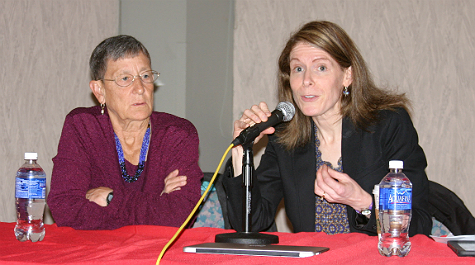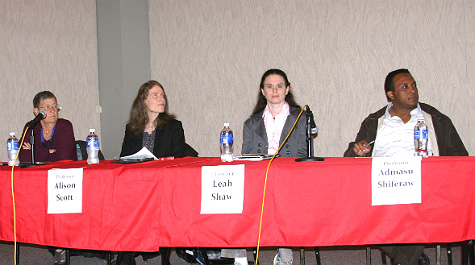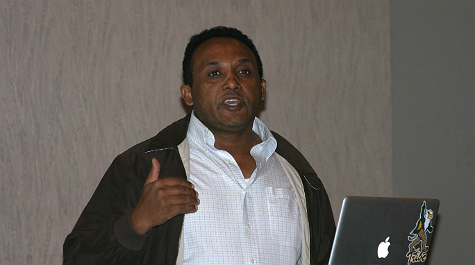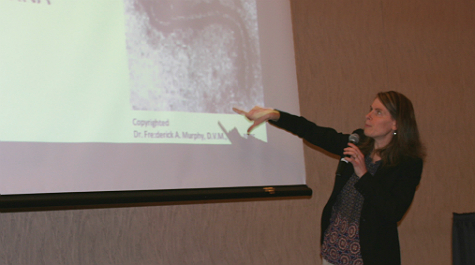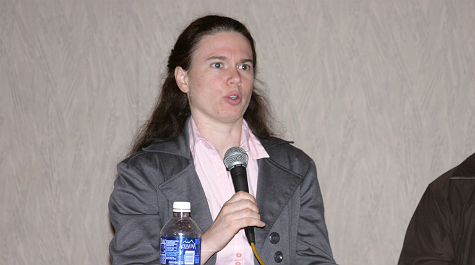Expert panel demystifies Ebola myths
Despite being an unavoidable topic in both conversation and the news, the Ebola virus remains mysterious to most people. In order to shed light on the disease, an interdisciplinary team of William & Mary experts gathered Wednesday night hoping to dispel fears through understanding.
Sponsored by student organization United Against Inequities in Disease (UAID), “Ebola Demystified: A Discussion Panel on the Current Outbreak” brought together a diverse team of scholars. Adjunct Professor Camilla Buchanan and Assistant Professor Alison Scott, both of the kinesiology and health sciences department, joined Assistant Professor of Applied Science Leah Shaw and Assistant Professor of Economics and Africana Studies Admasu Shiferaw in addressing a capacity crowd in the Sadler Center’s Tidewater Room. Molly Teague ’15, UAID president, moderated the discussion.
Demystifying the disease
Following a UAID video highlighting common misconceptions about Ebola among members of the university and Williamsburg communities, Buchanan and Scott began the evening with an epidemiological overview of the disease: where it’s from, what it does, how it spreads. On the topic of transmission, Scott was quick to dismiss the myth that Ebola spreads through the air.
“When we talk about something being transmitted through the air, what we’re talking about is viruses hitchhiking on microscopic particles of spit, in essence, and floating around in the air in the room,” Scott said. “That is not the case with Ebola.”
Buchanan concurred, citing the story of a United Nations worker who, after contracting the disease during the outbreak’s early days, fled from Sierra Leone to Nigeria seeking better treatment.
“He was really quite ill when he boarded the plane and landed in Nigeria, but the 200 people on the airplane remained Ebola-free,” Buchannan said. “It is not that easy to transmit this virus unless you have direct contact with someone.”
Scott cited the airborne transmission myth as just one negative result of alarmist media coverage and the trend toward appropriating the disease for political purposes.
“The Ebola outbreak has played into politics and campaigns for midterm elections,” she said, noting that such use “has fostered an inaccurate sense of risk that a lot of people in the U.S. have.”
Following the epidemiological overview, the discussion shifted to a more abstract mien as Shaw discussed methods for mathematically modeling the Ebola outbreak.
Such models are needed, according to Shaw, to test intervention techniques in order to best allocate the limited resources needed to fight the disease.
“In a model, you can check out certain types of isolation of patients and certain types of travel restrictions to determine their effects on disease spread,” Shaw said. “In real life, you have only limited resources and so testing it in a model to figure out what will work best can be a good approach.”
Shaw provided an overview of modeling techniques to illustrate the ultimate goal underlying the models: to get R0—that is, the rate of viral reproduction in each case—less than one. If R0 is greater than one, then more than one person contracts the disease for each patient and the disease proliferates. If it is less than one, then the disease declines.
In short, she concluded, her fellow applied mathematicians studying epidemic spread “are trying to figure out how best to deal with the situation in West Africa and what are the best ways to bring R0 below one.”
While Shaw’s presentation focused on modeling Ebola’s reaction to different forms of intervention, Shiferaw’s economic analysis concentrated on how Ebola-afflicted countries have responded to the disease’s spread.
Shiferaw emphasized that the West African countries stricken with Ebola are extremely poor—even by African standards—and are recovering from recent civil wars. The practical effect, he observed, is that their governments are scrambling to fund the fight against Ebola, often by gutting the countries’ capital budgets.
“In Liberia, for instance, work on the hydroelectric power plant on the St. Paul River expected to light most of the country by 2016 has come to a complete stop,” Shiferaw noted. “Less than one percent of the population currently has access to electricity in Liberia.”
The downsides to this resource shift in the Ebola fight are not limited to a weakened infrastructure.
“Over the last 10 years, these countries have made huge progress in reducing infant mortality rates,” he said. “The expectation is that these gains are going to be eroded as a result of this diversion of resources to focus on fighting Ebola.”
The solution to fear? Education
As the panelists began taking questions from the audience, a common concern about how to best guard against sensationalist reports about the disease became apparent.
“Reports in the media do not generally come with error bands,” Shaw said in response to a question about interpreting statistics found in news stories.
“When you read something in the media, take it with a grain of salt,” she advised the gathered students. “If it’s based on a good study, you can look up the original paper and see the statistics.”
Members of a university community are largely helpless when it comes to assisting the individual patients in West Africa. But that does not mean that college students must sit idly by.
“The most important thing that we can all do, and should do, is actually to become educated about what the risk is,” Buchanan said. “I think the more educated the American public is, then the more rational public policy can be.”
After all, she continued, if people exhibit a rational response when fears are blown out of proportion to the actual risk—as has happened with Ebola—then the policymakers will likewise take a measured approach in their reactions.
The panelists agreed: a solid grounding in the science underlying the epidemic is the best response to irrational fear. The key is putting risk into context and responding appropriately.
 Skip to main content
Skip to main content

